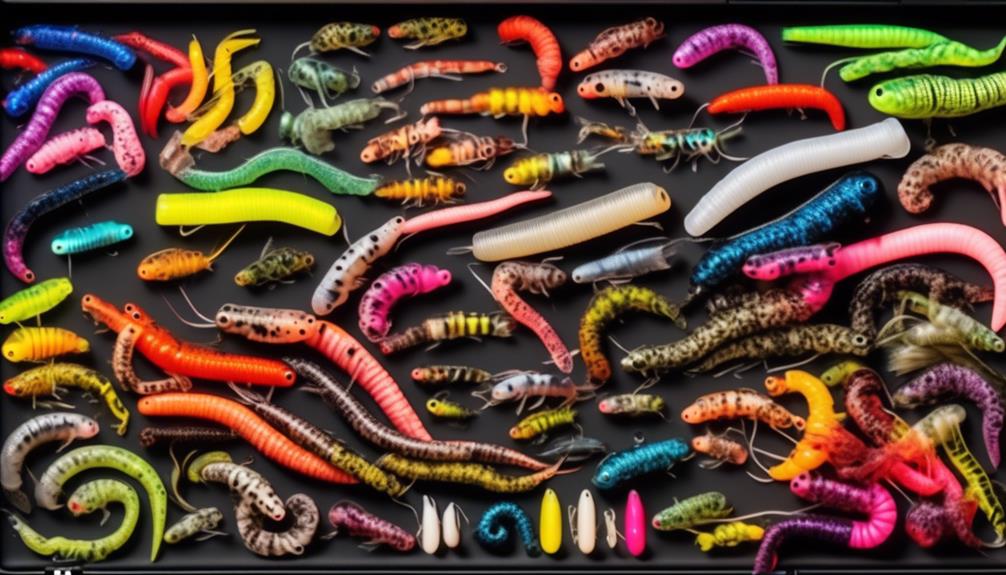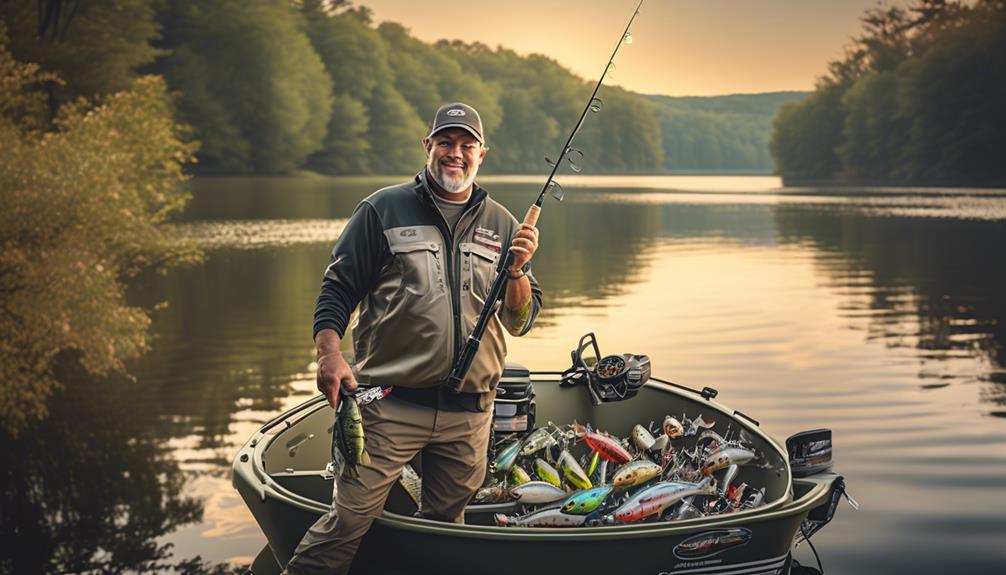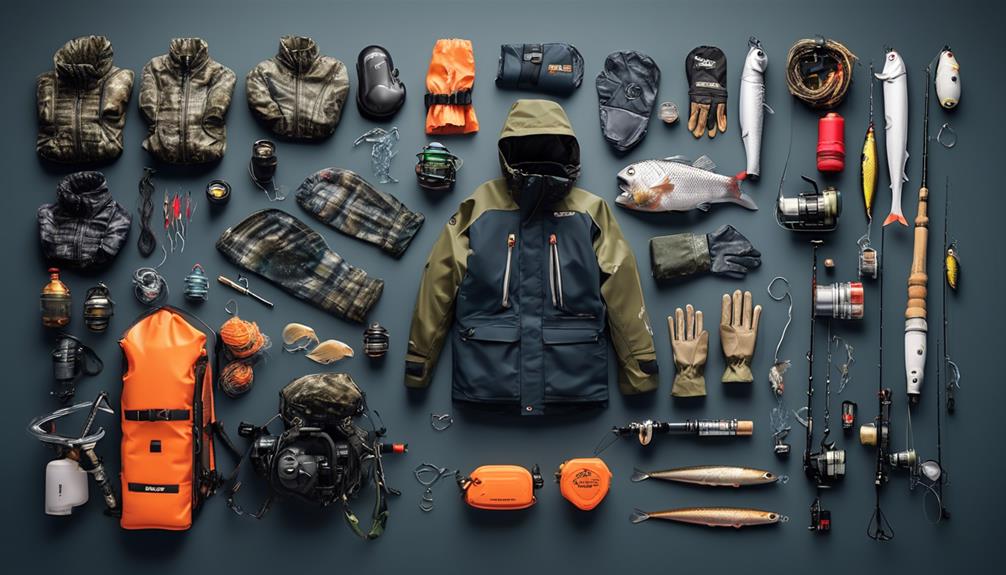So, you've spent countless hours researching the best tackle options for competitive bass fishing, only to find yourself overwhelmed by the endless array of choices. Well, fear not, because we've narrowed it down to the top three tackle options that will give you the competitive edge you're looking for.
Whether you're a seasoned angler or just starting out, these tried-and-true options are sure to up your game on the water.
But before we dive into the specifics, let's take a closer look at why these three options stand out from the rest.
Spinnerbaits
When targeting bass, you'll want to consider using spinnerbaits as they can attract fish with their flashy blades and vibrating action. To maximize your success, it's crucial to understand the best spinnerbait colors and retrieval techniques.
For murky water or low-light conditions, opt for spinnerbaits in chartreuse, white, or combinations of black and blue to enhance visibility. In clearer water, natural hues like shad, perch, or bluegill patterns are more effective. Experimenting with varying retrieval speeds, such as slow-rolling or burning the bait, can help determine the most productive approach on any given day.
Spinnerbait trailers can greatly improve the lure's performance by adding bulk, action, and even scent. Soft plastic trailers like paddle-tails or grubs provide extra movement, while adding a scent can entice hesitant bass.
Proper placement of the trailer is also crucial; ensure it doesn't impede the spinnerbait's blades or cause it to track unnaturally. By positioning the trailer so that it trails behind the spinnerbait skirts, you can maintain the lure's inherent action while enhancing its appeal.
Jigs
To continue your pursuit of bass, consider adding jigs to your tackle options, complementing the versatility of spinnerbaits with a different presentation style and target coverage. Jigs are effective for catching bass in various conditions and can be a valuable addition to your fishing arsenal.
When it comes to jig fishing, there are a few key elements to consider:
- Jig Trailers, Types, and Uses: Selecting the right jig trailer is crucial for success. From traditional pork trailers to modern soft plastic trailers, there are various options to choose from. Each type has its specific uses and can affect the way your jig moves in the water, making it essential to experiment and find what works best for you.
- Jig Fishing Techniques: Mastering jig fishing techniques is essential for maximizing your chances of catching bass. Learning how to effectively pitch, flip, and swim a jig can make a significant difference in your success on the water. Understanding when to use each technique based on the prevailing conditions is also critical.
- Tips for Success: Pay attention to details such as color selection, weight, and trailer action. Adjusting these variables based on the water clarity and weather conditions can greatly improve your chances of enticing bass to strike. Additionally, be patient and thorough in your presentations, as jigs are often most effective when fished slowly and methodically.
Incorporating jigs into your bass fishing repertoire can provide you with a powerful tool for targeting bass in a variety of environments and conditions. With the right knowledge and practice, jigs can become a go-to option for catching competitive bass.
Crankbaits
Consider adding crankbaits to your tackle options for a versatile and effective approach to bass fishing. Crankbaits are a must-have in any angler's arsenal due to their ability to cover water efficiently and trigger aggressive strikes from bass. When selecting crankbaits, consider the design and color options.
Crankbaits come in various designs such as shallow-diving, medium-diving, and deep-diving, each tailored to target different water depths. Additionally, they're available in an array of colors to mimic the forage in different fishing conditions. It's important to have a selection of crankbaits in various designs and colors to adapt to changing fishing environments.
To maximize the effectiveness of crankbaits, it's essential to master retrieval techniques and depth control. Experiment with different retrieval speeds, pauses, and jerks to find the right cadence that entices bass to strike. Varying the retrieval speed and adding occasional pauses can mimic a wounded baitfish, making the crankbait irresistible to bass.
Depth control is crucial, especially when targeting bass at specific depths. Pay attention to the diving depths of the crankbaits and use them accordingly to reach the desired strike zone.
Soft Plastic Swimbaits
Soft plastic swimbaits are versatile lures that can effectively attract bass in various fishing conditions. When choosing soft plastic swimbaits for competitive bass fishing, consider the following:
- Retrieval Techniques: Soft plastic swimbaits are best retrieved with a steady, medium-paced reel. You can also experiment with a stop-and-go retrieve to mimic the movement of injured baitfish, which can trigger aggressive strikes from bass.
- Optimal Sizes: Opt for soft plastic swimbaits in sizes ranging from 3 to 5 inches for competitive bass fishing. These sizes are ideal for targeting both small and largemouth bass in a variety of environments.
- Effective Color Patterns: Choose soft plastic swimbaits in natural colors such as shad, bluegill, and green pumpkin for clear water conditions. For murky water, opt for brighter colors like chartreuse and white to enhance visibility.
- Weedless Options: Select swimbaits specifically designed to be rigged weedless, especially when fishing in areas with heavy vegetation or cover. Weedless swimbaits reduce the risk of getting snagged and allow for a more seamless retrieval.
When using soft plastic swimbaits, it's essential to vary your retrieval techniques to find what works best on any given day. By understanding the optimal sizes, effective color patterns, and utilizing weedless options, you can effectively use soft plastic swimbaits to entice bass and gain an edge in competitive fishing scenarios.
Topwater Lures
When targeting bass with topwater lures, your retrieval techniques will shift from the steady, medium-paced reel used with soft plastic swimbaits to a more erratic and surface-focused approach. Topwater lure techniques are crucial for enticing bass to strike.
During the day, try a 'walk-the-dog' retrieve with lures like the Heddon Zara Spook. This involves twitching your rod tip to make the lure zigzag across the water's surface, mimicking the movement of a wounded baitfish. Alternatively, utilizing a popper or chugger, such as the Rebel Pop-R, can create a spitting action that attracts bass.
At night, bass tend to feed closer to the surface, making it an ideal time for topwater lures. Try using darker-colored lures for better visibility against the night sky.
Topwater lure modifications can enhance their effectiveness. For night fishing, consider adding glow-in-the-dark paint to increase lure visibility. Additionally, adjusting the size of the hooks on your topwater lures can improve hook-up ratios.
During seasonal variations, pay attention to the water temperature. In warmer months, bass tend to be more active, so using faster retrieval speeds or noisier topwater lures can yield better results. In contrast, during colder months, slower presentations and quieter lures, such as the Heddon Tiny Torpedo, can be more effective.
Adapting your topwater lure techniques to the time of day and season can significantly improve your bass fishing success.
Jerkbaits
For enticing bass to strike in various water conditions, incorporating jerkbaits into your tackle arsenal can be highly effective. Jerkbaits are versatile lures that can mimic injured baitfish, making them a go-to option for enticing bass in both clear and murky waters. When using jerkbaits, consider the following tips to maximize your success:
- Jerkbait retrieval techniques:
Experiment with different retrieval techniques to find what works best for the current conditions. Twitching your rod tip to make the jerkbait dart from side to side can imitate the erratic movement of injured baitfish, often triggering aggressive strikes from bass. Vary the cadence of your jerks and pauses to find the rhythm that entices the most strikes.
- Jerkbait color selection:
The color of your jerkbait can make a significant difference in its effectiveness. In clear water, natural and translucent colors like silver, pearl, or shad patterns can be highly effective. In murky water, opt for brighter, more visible colors such as chartreuse, orange, or red to help bass locate the lure more easily.
Finesse Worms

To continue expanding your tackle options beyond jerkbaits, consider adding finesse worms to your arsenal for enticing bass in various fishing conditions.
When it comes to finesse worms, selecting the right color is crucial for maximizing your chances of a successful catch. Natural earth tones like green pumpkin, watermelon, and black are reliable choices for clear water, while bolder colors such as junebug, red shad, and chartreuse can be effective in stained or murky waters. Remember that water clarity and light conditions play a significant role in determining the ideal worm color for the day.
Now, let's talk about rigging techniques. One popular method is the Texas rig, where the hook is buried into the worm to make it weedless and presented snag-free in heavy cover. This rigging style allows the finesse worm to be flipped or pitched into dense vegetation without getting caught, making it a versatile choice for navigating through challenging fishing environments.
Another effective technique is the wacky rig, where the finesse worm is hooked through the middle, creating a more natural and tantalizing action as it falls through the water column. The wacky rig is particularly effective in open water scenarios or when bass are in a less aggressive feeding mood.
Incorporating finesse worms into your bass fishing repertoire can greatly enhance your ability to adapt to different conditions and entice wary bass. By carefully considering worm color choices and mastering various rigging techniques, you'll be well-prepared to tackle the challenges of competitive bass fishing.
Carolina Rigs
Consider incorporating Carolina rigs into your bass fishing arsenal for a versatile and effective approach to enticing bass in a variety of fishing environments. Carolina rigs offer several advantages, making them a popular choice among anglers. They allow you to cover a lot of water efficiently and can be fished in various depths and terrains. However, like any technique, Carolina rigs also come with their own set of disadvantages. They can be prone to snags and require some practice to master the art of setting the hook effectively.
When using Carolina rigs, there are some modifications and techniques that can enhance their effectiveness. Here are a few to consider:
- Adjust Leader Length: Experiment with the length of the leader between the weight and the bait to find the optimal setup for the specific conditions you're fishing in.
- Use Beads and Clackers: Adding beads or clackers to the rig can create additional noise and vibration, increasing its attractiveness to bass.
- Vary Weight Sizes: Changing the weight size allows you to adapt to different depths and bottom structures, ensuring your rig stays in the strike zone.
- Master Dragging and Hopping: Learn the art of dragging the rig along the bottom and hopping it intermittently to mimic natural bait movement.
Frequently Asked Questions
What Are the Best Tackle Options for Fishing in Heavily Weeded Areas?
When fishing in heavily weeded areas, tackle preferences can make a big difference. Using techniques like flipping or pitching can help you navigate through the weeds and reach the bass hiding in there.
Opt for heavy-duty rods and reels, along with strong braided line to handle the thick cover. Consider using weedless lures like jigs, Texas-rigged soft plastics, or topwater frogs to avoid getting snagged.
Are There Any Specific Tackle Options That Work Best for Bass Fishing in Deep Water?
When you're targeting bass in deep water, it's essential to have the best lures and line and rod options.
Consider using deep-diving crankbaits, swimbaits, and football jigs to reach those deeper bass.
For the line, fluorocarbon is a good choice as it sinks and is less visible.
Opt for a sensitive and strong rod to handle the deeper water pressure.
These tackle options are crucial for successful deep water bass fishing.
What Tackle Options Are Best for Targeting Larger Bass in Open Water?
When targeting larger bass in open water, topwater techniques can be effective for drawing strikes.
Finesse fishing with light line and small lures can also entice wary bass.
Additionally, jigging techniques and selecting the right crankbait can produce results.
It's essential to adjust your approach based on the conditions and the behavior of the bass.
Experimenting with different tackle options will help you find what works best for your specific fishing situation.
Are There Any Specific Tackle Options That Work Best for Bass Fishing in Murky or Stained Water?
When fishing in murky or stained water, tackle selection and fishing techniques are crucial.
Opt for lures with vibrant, contrasting colors to stand out in low visibility. Consider using chatterbaits, jigs, or large plastic worms to create vibrations and attract bass.
Fluorocarbon line can also aid in visibility.
Adjust your retrieval speed and focus on covering more area to increase your chances of enticing strikes in these conditions.
What Are the Best Tackle Options for Fishing in Areas With Heavy Current or Strong Winds?
When fishing in areas with heavy current or strong winds, it's crucial to use the right tackle options.
Look for lures designed to perform well in fast currents and windy conditions. Opt for heavier jig heads and lures with a more streamlined design to help them stay in place.
Consider using crankbaits and spinnerbaits that can cut through the water more effectively.
These tackle options can help you navigate challenging fishing conditions.
Conclusion
So, when it comes to competitive bass fishing, you have a few great tackle options to choose from. Whether you prefer spinnerbaits, jigs, crankbaits, soft plastic swimbaits, topwater lures, jerkbaits, finesse worms, or Carolina rigs, each option has its own unique advantages.
Experiment with different tackle options and see which ones work best for you in different fishing conditions. Keep practicing and honing your skills, and soon enough you'll be reeling in those big bass.
Happy fishing!



